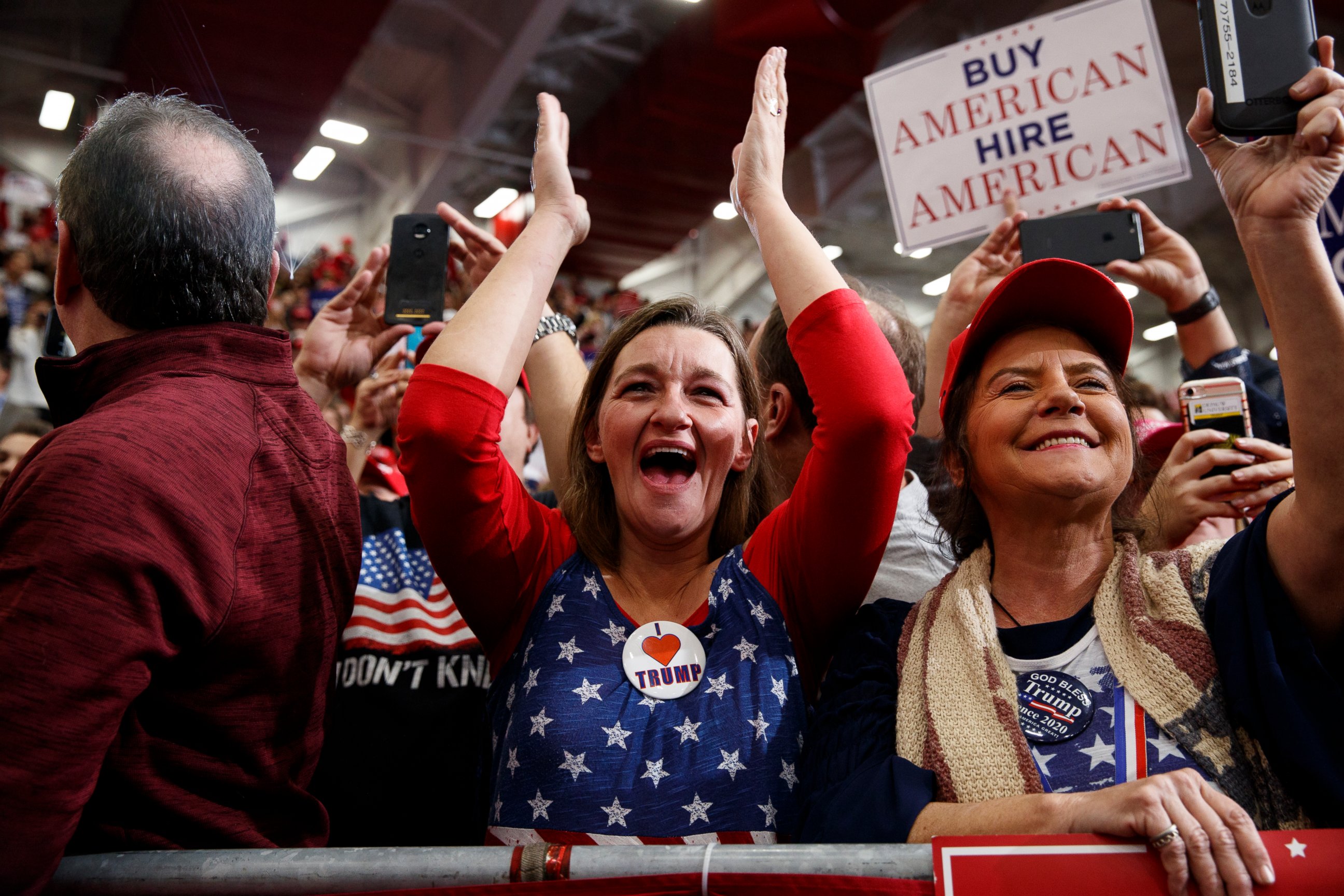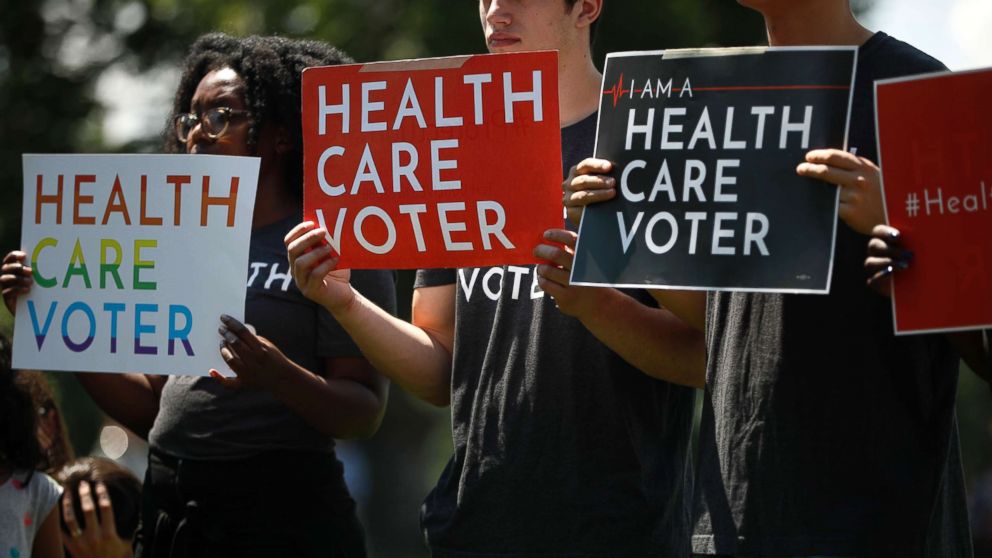It's Democrats +8 in likely voter preference, with Trump and health care on center stage
President Trump’s unpopularity and a broad gap in trust to handle health care are keeping Democrats in the hunt to take control of Congress, but with an advantage that’s narrowed from its summertime peak.
Democratic House candidates lead Republicans 52-44 percent among likely voters in this final ABC News/Washington Post pre-election poll. The Democrats’ lead has closed from 14 percentage points in August and 13 points in October to now 8 points.
See PDF for full results, charts and tables.
The GOP has seen some shoring in its base, including non-college white men and rural residents, as well as among independent women. At the same time, vote intention remains high in typically low-turnout Democratic groups, including young voters, nonwhites, liberals, Democrats and those who lean toward the party.
With Trump pushing to turn out his core support groups, the election stands more than ever as a referendum on his presidency. That’s not ideal for the Republicans: Trump’s 40 percent approval rating is the lowest for a president ahead of his first midterm elections besides Harry Truman’s in 1946. Trump’s average approval from inauguration to his first midterm is the lowest on record.

Trump's approval rating matters because 59 percent of likely voters say it’s highly important to them to vote for a candidate who shares their opinion of Trump -- down from a high of 64 percent in October, but still a solid majority. And Trump’s approval among likely voters is 9 points underwater.
The Democratic lead in this poll, produced for ABC by Langer Research Associates, in no way makes the election outcome a done deal. One concern for the Democrats is their over-vote in safe districts. In those districts rated solid or likely Democratic by the ABC News Political Unit, Democratic candidates lead by a vast 67-29 percent. In solid or likely Republican districts, it’s a 58-35 percent Republican lead. And in leaning or toss-up districts, it’s close: 49-44 percent for Democratic vs. Republican candidates.
Further tea leaves come from the 14 percent of registered voters who, as of late last week, said they’d already cast their ballots. They split exactly evenly: 49-49 percent. Notably, 44 percent of them are senior citizens, generally a more pro-Republican group.
Turnout
Conventional wisdom holds that to do well the Democrats need at least a 10-point margin among registered voters before a midterm election, because their support drops among those who actually turn out. But anti-Trump motivation may change the equation. Unusually, the Democrats don’t lose ground in the shift from registered voters -- where they are +7 points -- to likely voters, at +8.
Vote intention is high across the board: 80 percent of registered voters say they’re certain to vote this year or already have done so, compared with 65 percent at this point in 2014 and 71 percent in 2010. But it’s unusually high, in particular among Democratic groups. Three-quarters of nonwhites say they’re certain to vote, compared with 49 percent at this point in 2014. And 69 percent of registered voters age 18-39 say they’ll certainly vote, up from 44 percent in the last midterms.
Similarly, intention to vote is up by 24 points among liberals and 18 points among moderates compared with 2014, vs. 6 points among conservatives. It’s up 9 points among Republicans and Republican-leaning independents, compared with a 20-point jump among leaned Democrats.
Democrats are less advantaged here than it might seem, because registration rates are lower in some of their core groups, particularly young adults and nonwhites. Regardless, having inspired these higher vote intentions, the challenge for Democrats, as always, is to actually turn them out.
Groups
Group-level vote preferences matter as well as turnout, and here, as noted, the GOP has seen some gains. The party’s candidates led by 27 points among non-college white men last month; it’s 39 points now. Surprisingly, they had only 9- and 10-point leads among rural residents in August and October, while it’s 33 points today. And the party’s improved since last month among white Protestants, evangelical and non-evangelical alike.
There’s also a change among women; they went from 25- and 22-point Democratic margins in the last two ABC/Post polls to 14 points now, while men continue to divide evenly. The shift chiefly is among rural women. Suburban women, for their part, favor Democrats by 11 points, same as October but down from 21 points in August.
Another notable change comes among independent women, who now divide about evenly among Democratic and Republican House candidates, 43-41 percent, after a 33-point Democratic preference in October. This reflects more conservatives and whites, and fewer liberals and nonwhites, in the ranks of independent women. It’s produced a tighter contest among independents overall, now dividing 48-41 percent between the Democrats and Republicans.
Countervailing changes on the Democratic side have been slighter, leading to the somewhat closer contest overall.
Issues
As noted above, health care is key to the Democrats’ prospects; they lead in trust to handle the issue by 50-34 percent, a 16-point margin that’s unchanged from last month. Moreover, health care now leads the list in salience --– 78 percent call it highly important in their vote choice, numerically (albeit not significantly) ahead of the economy, 76 percent.
At the same time, in the face of Trump’s focus on immigration, trust to handle that issue has moved slightly from a clear Democratic advantage last month, 50-39 percent, to a divided 47-42 percent now. Republicans lead, 49-39 percent, in trust to handle the related issue of border security. Sixty-seven percent call immigration highly important in their vote (it was 70 percent last month), while 59 percent say the same about border security, ranking it sixth in a list of seven issues. It’s the first time ABC/Post has asked about trust to handle border security, but Fox News had +14 and +11 Republican results in June and September, and the Post had Trump +10 over the Democrats on the issue in July – all indicating no change, despite the president’s recent focus on a so-called caravan of migrants from Central America.
As reported Friday, the Democrats have a 15-point lead in trust to handle reducing divisions between people and groups (rated highly important to 69 percent of respondents). Their biggest advantage, a vast 32 points, is in trust to handle global warming, though comparatively few, 48 percent, call this highly important in their vote.
There’s a close division, 45-41 percent between Republicans and Democrats, in trust to handle taxes. It’s typically a concern for the Republicans when the Democrats are competitive on this issue -- and a 9-point GOP advantage exists in trust to handle the economy.
Focusing on health care as the top issue, it’s notable that the Democratic advantage is similar among men and women. It disappears among seniors, who split evenly, widens among college-educated adults, and is +16 points for Democrats in the suburbs. But it flips to +24 points for the Republicans in rural areas. Political independents favor the Democrats in trust to handle health care by a 20-point margin.
There are differences on the virtually as-important issue of the economy. Women divide in trust on this issue while men favor the GOP by 22 points. Young adults, the Democrats’ best age group, only divide evenly, while seniors go +17 points for the Republicans. So do suburban voters and independents, both by 14 points.
Attitudes on the issues also are useful to view in profile, by vote preferences. Among those who say that health care is highly important in their vote, there’s a 57-37 percent Democratic lead in House vote preferences, and it’s identical among those who prioritize reducing divisions among people and groups. The GOP has a 22-point lead, 59-37 percent, by contrast, among those who call border security highly important in their vote. It’s essentially a dead heat among those who focus on the economy, immigration and taxes. And it’s a whopping +56 points Democratic among those who call global warming highly important in their vote for Congress.
The economy
The economy is worth another look, as 65 percent of all adults say it’s in excellent or good shape, compared with just 38 percent heading into the 2016 presidential election and 27 percent before the 2014 midterms. One reason it doesn’t accrue all that much to the Republicans’ benefit is that there’s a lot of partisanship in this view. It’s 86 percent among leaned Republicans vs. 52 percent among leaned Democrats.
Another factor is that folks are a lot less likely to say they are doing better financially now compared with when Trump took office. Just 25 percent say they’re better off; few are worse off, 13 percent, leaving 60 percent saying they’re in about the same shape.
It’s reflected in vote preferences. Among “better off” voters, 87 percent favor Republican congressional candidates. Among those who are worse off, 86 percent favor Democrats. And the majority who say they’re in the same shape back Democrats as well, by 62-30 percent.
Methodology
This ABC News/Washington Post poll was conducted by landline and cellular telephone Oct. 29-Nov. 1, 2018, in English and Spanish, among a random national sample of 1,255 adults, including 1,041 registered voters. Results have a margin of sampling error of 3.0 points for the full sample and 3.5 points for the sample of registered voters, including the design effect. Partisan divisions are 32-25-35 percent among all adults, and 33-27-34 percent among registered voters, Democrats-Republicans-independents.
The survey was produced for ABC News by Langer Research Associates of New York, New York, with sampling, data collection and tabulation by Abt Associates of Rockville, Maryland. See details on the survey’s methodology here.




